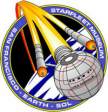 |
 |
 |
Klingon D6 Cruiser
![]() Diagrams
Diagrams![]()
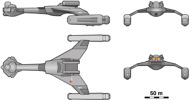 Orthographic views |
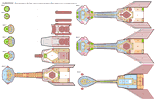 Deck plans, part 1 created by Allen Rolfes (see notes) |
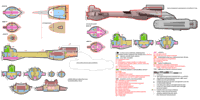 Deck plans, part 2 created by Allen Rolfes (see notes) |
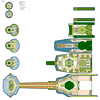 Bluescale plans, part 1 created by Allen Rolfes (see legend) |
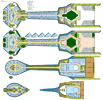 Bluescale plans, part 2 created by Allen Rolfes (see legend) |
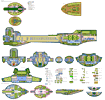 Bluescale plans, part 3 created by Allen Rolfes (see legend) |
![]() Scenes
Scenes![]()
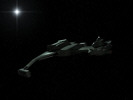 D6 scene created by Brian Minosh |
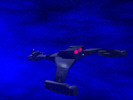 D6 scene created by Brian Minosh |
 D6 scene created by Torsten Loeskow |
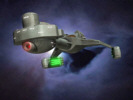 D6 scene created by Torsten Loeskow |
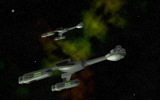 D6 duo created by Thomas Pemberton |
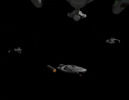 Pyotr Velikiy in a Klingon trap created by Thomas Pemberton |
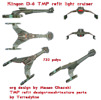 D6 refit model created by Terradyhne |
![]() History
History![]()
The early years of the 23rd century were trying times for the Klingon Empire. An extremely violent struggle for the Chancellorship ended in 2228 with the Empire politically divided and military weakened. Vital resources that could have been used to expand the power and influence of the Empire were instead squandered on internecine conflict. Although the quality of their cruisers had markedly improved by the late 2230s and given the Klingons some measure of success against the Romulans, they remained largely impotent against the Federation. All Klingon attempts to push the frontier spinward had been thwarted by Starfleet's highly capable Valley Forge- and Kestrel-class ships, which remained qualitatively superior to the Klingons' newest D5 cruisers. The Federation ships' high speed, local basing, and dedicated, well-trained crews allowed them to respond quickly to any Klingon border incursion and quickly provide reinforcements from rear areas.
However, a possible weakness in the Federation's defenses lay in the relatively small number of ships in service. Although Starfleet monitored the entire Klingon-Federation frontier, the defenses were actually quite shallow and uneven. Normally, Kestrel light cruisers or ships of similar capability were based at border colony systems closest to Klingon-held star systems; however, most sections of the border, especially those more than 10 ly from Klingon-held systems or those without inhabited planets, were monitored only by unmanned automated sensor drones, which were often of short range and low power. If the Klingons could concentrate and apply overwhelming force at a single point on the border and defeat any reinforcements that could respond immediately, they might be able to capture and hold a solar system, which would then serve as an advance base for further operations. For such a plan to succeed, the Klingons would need a large number of very fast ships.
Although the D5 was considerably smaller and faster than earlier Klingon cruisers, it was still burdened by a fusion reactor capable of achieving warp speeds. This fusion reactor, and its deuterium supply, weighed some 10,000 t but was used to power warp flight only when the matter/antimatter (M/AM) reactor was off-line because of maintenance or malfunction. However, the added weight of the fusion reactor and its fuel handicapped performance at warp and impulse speeds at all times. Despite significant advances in Klingon reactor design in the preceding decades, the possibility of malfunction was still significant, albeit low, on long-range cruises. However, for the type of short-range attacks being planned in the late 2230s, the most recent Klingon reactors were considered sufficiently reliable that back-up fusion reactors could be dispensed with. Therefore, the next generation of Klingon warships could be made considerably smaller with an emphasis on short-range speed and striking power rather than on long-range cruising.
Design work on a new Klingon strike cruiser to support this new offensive doctrine was started in 2236. The resulting D6 cruiser, which entered service in 2241, was a radical change from the preceding D5 class both internally and externally. All ship's systems were designed to provide extremely high levels of performance with little regard for long-term reliability. To reduce weight, the only warp reactor carried was a compact 3rd-generation M/AM reactor of completely Klingon design that could sustain output at near-maximal levels for approximately 150 hours without shutdown. However, after operating at such levels for a total of 500 hours, overhaul in drydock was required to prevent catastrophic malfunction. The relatively large nacelles (accounting for nearly half of total displacement) were able to handle extremely high levels of channeled power and achieve maximum speeds for days at a time. However, their warp coils had to be replaced after a stunningly short 250,000 cochrane-hours. (In contrast, contemporary Federation nacelles were normally rated for at least 10 million cochrane-hours.) Therefore, the warp coils would be entirely depleted by cruising at wf 7 for less than 30 days.
Other aspects of the ship also reflected its short-range strike role. Although the D6 carried a fusion reactor, it was small and powered only the impulse drive, energetic shielding, and beam weaponry. The impulse drive was a high-capacity, high-consumption system which, again, was designed to provide extremely high thrust levels for short periods of time. Crew quarters and life support machinery were decreased to the minimum necessary for strike missions lasting at most 1 or 2 months. The command head, which mounted a powerful disruptor cannon on its midline and smaller disruptors under the brim of the "hat," was separated from the engineering hull by a neck 60 m long but only 14 m wide. The 34-m-wide engineering hull itself was barely large enough to house the M/AM reactor, AM containment bottles, deuterium tanks, and the small fusion reactor. The engineering hull retained the deep rear-ventral fantail of the D5. The wings supporting the warp nacelles were also of new "cranked" configuration that would be characteristic of later Klingon designs: the inner wings section had a slight upper-surface anhedral (13 degrees) but were swept back 62 degrees; in contrast, the outer wing sections were swept back only 46 degrees but were angled downward 28 degrees.
As soon as the design for the D6 was finalized, large-scale production started at three Klingon shipyards, each controlled by a different Great House. By early 2241, some 30 D6 cruisers had been constructed. The Klingon High Council was extremely pleased by the D6's performance in trials: in its supercruise mode, the D6 was able to sustain a speed of wf 7.6 and cross a 5-ly distance between neighboring star systems in less than 5 days. The D6's maximum speed of wf 7.9 made it marginally faster than the Federation's two fastest ships, the Valley Forge class (wf 7.6) and the Kestrel class (wf 7.4), neither of which could sustain its maximum speed for as long as the D6.
Service History
By midyear, the D6 class was declared ready for service. Rather than immediately putting the D6 into action against the Federation, the Klingons chose to test the D6 against the Romulans at a point far from possible Starfleet surveillance. When the Federation finally met the D6 in action, the Klingons hoped it would be an unpleasant surprise.
In May 2242, a task force of 9 D6s converged from three directions on the Romulan colony world of T'lach Kor, which had been taken from the Klingons some 50 years earlier. Although this planet was of little military value and had few resources, it enabled the Klingons to stage a dress rehearsal for their planned attacks against the Federation. Working in standard three-ship teams, the D6s quickly dispatched 4 Romulan Capsize-class cruisers after they had decloaked and fired plasma cannons at close range. One Klingon cruiser was destroyed and another was severely damaged. The Klingons shrugged off these losses and entered orbit around the planet. After a light orbital barrage lured ground and orbital defense batteries into returning fire and revealing their positions, the Klingons initiated an even heavier bombardment of the surface which included atomic weaponry to excavate deeply buried command centers and bunkers. After all defensive batteries had been silenced, assault troopers were landed by transporter to claim the still-smoldering planet for the Klingon Empire. None of the 5,000 Romulan colonists and defenders had survived the attack.
Several days later the surviving Klingon ships rendezvoused with five additional D6s and replenishment/repair and recreation ships in orbit around T'lach Kor. The task force then set off for the next target, Motak Fal'tir, 5 ly deeper within Romulan space. This planet had also been taken from the Klingons half a century earlier. Although the Romulans had anticipated this attack and massed a defensive force of fighters and old Cracker-class cruisers, they were no match for the faster, more powerfully armed D6s. Motak Fal'tir fell with the loss of an additional 9,000 Romulan lives. Over the next 6 months, the Klingons captured eight more star systems controlled by the Romulans. By the time the offensive was suspended in favor of operations against the Federation, the Klingons had reclaimed some 700 ly^3 of Romulan space.
The Klingons were well aware that success against the Federation would not come so easily. The Federation was a young, strong, and rapidly expanding empire, although it did not consider itself one. However, the Federation system of limited self-determination within a mutual-defense organization was as threatening to the Klingons as the H'urq had been a millennium earlier. The Klingons believed that the Federation would likely attempt to absorb both the Klingon and Romulan Empires. That the Federation was driven by a race, the Humans, that had been traveling to the stars for less than 200 years was the fact the Klingons found most unbelievable and alarming. These Humans were like a newly developed cancer, gleefully spreading and metastasizing from system to system across the galaxy. In fact, the Klingons had received reports that star systems were most often willingly absorbed by the Federation and could even decline membership. Although the Klingons doubted that the latter was true, they concluded that these Humans must certainly be very devious, very persuasive, or very cruel. The Klingons were determined to do everything in their power to avoid becoming the next race compelled to "join" the Federation.
Military success against the Federation's Starfleet would depend on surprise, violence, and a great deal of luck. Although Federation defenses at the border were quite sparse, the system was flexible enough to allow forces to be redistributed to sectors where attack was considered most likely. If Starfleet were to detect a threatening concentration of Klingon forces, it would quickly redeploy ships from rear areas in an attempt to either deter or defend against an attack. However, a Klingon attack would require a local superiority of forces to succeed. To accomplish this, Klingon began to send ships one by one to the attack staging area within the asteroid belt of the Delta Tetsuwan system. To avoid emitting revealing warp signatures, D6 cruisers traveled far slower than their normal cruising speeds, often in the company of regularly scheduled cargo ships and transports to further obscure their identity.
By the middle of January 2244, 12 D6s, including 6 veterans of actions in Romulan space, and numerous support vessels had been assembled for the attack. Because the Klingons did not yet have completely effective cloaking systems, early warning stations guarding Federation borders would need to be neutralized. For this reason, the Klingons had obtained an obsolete Earth-registered merchantman, SS Virginia, which slipped across the frontier on January 10. On January 20, Virginia, transmitting false distress signals and packed with primitive antimatter munitions, slammed into the unmanned Federation border monitor station on Beta Tetsuwan XII, destroying it completely. Starfleet, believing that the loss of sensor contact was attributable to this accident, sent a Kestrel-class light cruiser (USS Shrike, NCC-1434) at its cruising speed of wf 5.5 to investigate. Fourteen hours later, the Klingon D6s, which had crossed the frontier using their supercruise mode, streaked in to destroy the Federation base at Cicatrix IV, despite a valiant defense by USS Cougar (NCC-1468, Valley Forge class). The Klingons next turned towards the Federation colony at Massirof, but were intercepted at Donatu V by a mixed force of 10 ships of the Lancaster, Valley Forge, and Siegfried classes mounting photon torpedoes (See the Valley Forge article for additional details). Three badly damaged Klingon ships attempted to return to Klingon space but were destroyed by pursuing Kestrels while crossing the frontier. The support ships waiting at Beta Tetsuwan were also hunted down and destroyed. A simultaneous but smaller attack at Tassem-Loki III resulted in the loss of an additional 6 D6s and the lives of 223 Federation citizens.
The annihilation of the Klingon battle fleets at Donatu V and Tassem-Loki III marked the last major Klingon offensive until the Four Days' War of 2267. The loss of 18 newly constructed warships, numerous support ships, and an estimated 7,500 Klingons sailors and soldiers led three Great Houses to declare their refusal to participate in any additional "futile" attacks upon the Federation and precipitated yet another violent struggle for the Chancellorship. The Romulans took advantage of the chaos within the Klingon Empire to launch their own attacks in an attempt regain the colonies they had lost a year earlier. The Klingons had no choice but to respond in kind, leading to pitched battles often involving scores of ships and lasting weeks at a time. Until the mid-2250s, the Romulans and the Klingons fought countless battles over the same handful of star systems which led to a slow coreward shift of the border. Although the Klingons could claim some success in their attempts at territorial expansion, the cost in both men and materiel was horrific. Both sides eventually came to realize the futility of continued combat while their mutual enemy, the Federation, grew more powerful. The two empires entered into a short-lived alliance and technology exchange in the 2260s.
Based on their incomplete understanding of the Earth-Romulan War of the previous century, the Klingons fully expected the Federation to mount retaliatory or preemptive attacks upon Klingon territory. However, the Federation of 2244 was very different from the United Earth of 2154. Some 80 years after its founding, Starfleet was still dominated by officers from Earth and former Earth colonies. Many Human admirals of Starfleet Command advocated a formal declaration of war against the Klingon Empire to end Klingon aggression once and for all. However, Starfleet was still under the control of the Federation Council, whose membership more accurately reflected the diversity of the Federation. Most Federation member worlds were simply not willing to support total war with the Klingon Empire when occasional border attacks could be successfully repelled by Starfleet with minimum loss of life. Furthermore, the Federation decided that seeking retribution, even for the deaths of more than one thousand Federation citizens, was inconsistent with its basic principles.
The Klingons came to realize that the Federation was now unlikely to invade Klingon space or to attempt to destroy the Klingon Empire, despite the opinions of some hawks within Starfleet. On the other hand, the Klingons also now understood that the Federation would stop at nothing to defend its own territory. The Klingons, like most empires ruled by a single race, had considered the Federation a degenerate, mongrel power that would split apart when seriously challenged by outside forces. Although the Klingons had fought numerous engagements with Starfleet in the last quarter century, they seemed, nevertheless, compelled to learn only through a final bitter defeat that the Federation would never yield a cubic meter of its territory to a hostile power.
![]() Specifications
Specifications![]()
Standard displacement: 100,000 t
| Overall | 1° Hull | 2° Hull | Nacelles | |
| Length [m] | 228.98 | 43.89 | 154.64 | 88.65 |
| Beam [m] | 135.11 | 42.79 | 114.38 | 13.62 |
| Draft [m] | 51.40 | 29.67 | 330.19 | 23.06 |
Complement: 250
Weapons: 2 disruptor cannons, 1 heavy disruptor cannon or 1 missile launcher with 74 "Muffin" missiles
Velocity: wf 5.8, cruise; wf 7.6, supercruise; wf 7.9, maximum
Units commissioned: 85
![]()